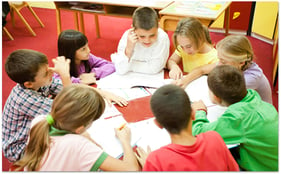What Is A Project Based Learning Approach
Here are 3 characteristics of meaningful project based learning activities that lead to deeper student understanding: Project based curriculum is designed to engage students using existent-world problems. This is an interdisciplinary approach because real-earth challenges are rarely solved using information or skills from a single bailiwick area. Projects require students to engage in enquiry, solution edifice, and product construction to assistance address the issue or challenge presented. As students do the work, they oftentimes use content knowledge and skills from multiple bookish domains to successfully complete the projection. Project based educational activity requires the application of knowledge and skills, not but recall or recognition. Unlike rote learning to assess a single fact, PBL assesses how students apply a diversity of bookish content in new contexts. Equally students appoint in a project, they brainstorm with asking a question. Inquiry leads the student to call up critically as they are using their bookish knowledge in real-globe applications. The inquiry process leads to the development of solutions to accost the identified problem. They show their noesis in action through the creation of products designed to communicate solutions to an audience. In PBL, the office of the teacher shifts from content-deliverer to facilitator/project manager. Students work more independently through the PBL procedure, with the teacher providing back up only when needed. Students are encouraged to brand their own decisions nearly how best to do their work and demonstrate their agreement. The PBL process fosters student independence, buying of his/her piece of work, and the development of 21st century/workplace skills. Research on PBL supports an increment in educatee engagement, achievement, and encourages the development of 21st-century skills students need to succeed in their future careers. For example, four teachers from four different classrooms at Huntington Heart School (PA) used their individual strengths in a rotational, projection-based model to teach middle school students how to employ STEM to real-earth situations. The team included a engineering instructor, the library media specialist, math instructor, and science instructor who divide the students into four classes and rotated them every three days. During the nine-calendar week project, students were tasked to use STEM and ELA skills to create their ain artificial island. They used knowledge from all four teachers to finish the multifaceted, cross-curricular project and presented to their classmates. Hear the benefits of this model in a free webinar here . Dr. David Reese is a strong supporter of PBL in education, "When working with educators, I frequently find educators see the final production of the project as the learning. This may be partially correct, but my belief is that process is how we provide students with opportunities to attain high levels of Flower'southward taxonomy and utilize important 21st-century skills." Opportunity based projects go across the content and truly fix students for the modern workforce . At Diamond Springs Unproblematic School in Virginia Embankment, VA, 1st grade teacher Amber Bush used the Reporter performance chore to help students find what growing up was like for adults in their life. Fourth graders in Paul Karlovics classroom studied earthquakes through the lens of an emergency services coordinator . They had to determine how to brand the city safer during an earthquake by recommending different materials and presenting new ideas. These examples, plus many more , show how real-globe tasks give students a deeper agreement of concepts through relevant and authentic learning experiences. A quick Internet search brings up many additional ideas and examples of ways to present content virtually. For instance, record your presentations, use other videos, mail online readings, and other resource, institute small-scale, online written report teams, and so on. Kids will also need ways to respond virtually and regularly communicate with you and one another online. Remote learning makes it simple to promote student choice, foster the evolution of digital citizenship skills, and extend learning to meet students' interests and needs. Hither are 5 ways Divers Learning tin facilitate remote learning . For information on getting started with PBL, check out these articles written past educators who are passionate virtually engaging their students in PBL. Download the FREE guide to projection based learning today! Project Based Learning (PBL) is an instructional methodology encouraging students to learn by applying knowledge and skills through an engaging experience. PBL presents opportunities for deeper learning in-context and for the evolution of of import skills tied to college and career readiness.
Project Based Learning (PBL) is an instructional methodology encouraging students to learn by applying knowledge and skills through an engaging experience. PBL presents opportunities for deeper learning in-context and for the evolution of of import skills tied to college and career readiness. Characteristics of Project Based Learning
1.) Interdisciplinary
two.) Rigorous
3.) Student-centered
Examples of Projection Based Learning in Educational activity
Hither are iv reasons to adopt a project based learning model:
![]()
Subscribe to the #1 PBL Weblog!
Receive new articles in the world of Project Based Learning, Stem/STEAM, and College & Career Readiness.
What Is A Project Based Learning Approach,
Source: https://blog.definedlearning.com/blog/what-is-project-based-learning
Posted by: taylorwhick1956.blogspot.com


0 Response to "What Is A Project Based Learning Approach"
Post a Comment